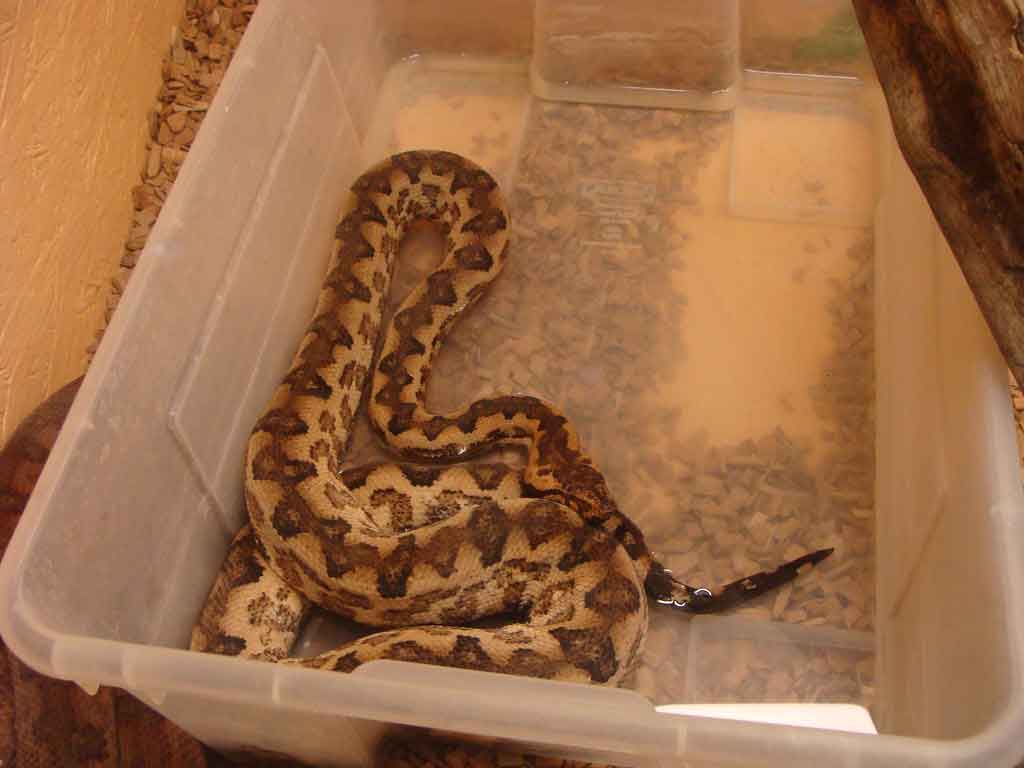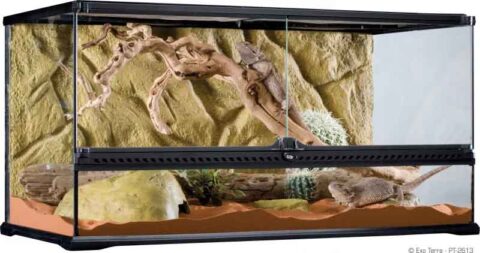
Content |
|---|
Origin / Distribution
The New Guinea ground boa (Candoia aspera) is present in Papua New Guinea, Irian Jaya, various Indonesian islands, the Moluccas, the bismarck archipelago, the Solomon Islands and the Tokelau Islands.
Subespecies list
- Candoia aspera aspera (Günther, 1877)
- Candoia aspera schmidti (Stull, 1932)
Characteristics / Appearance
The New Guinea ground boa It is a species of relatively small boa. On average, this snake only reaches a few 60 cm., the individuals of 80-100 cm are a big exception. The scales are strongly rough/ribbed and they have a stocky physique and the tail is relatively short – only 7-8% of the total length. The reason why this species in English is sometimes called “Viper boas” It is because of the similarity in terms of complexion and pattern with the death adder (Acanthophis) which also occurs in the same area. They blend in perfectly with their surroundings and camouflage well.
Habitat
Its natural habitat consists of moist lowlands, forests and swamps where the water level is under the influence of the tides and the rainy season. It is not uncommon for these regions to be seasonally flooded.
Behavior
The species is mainly nocturnal and moves on the ground and is only occasionally found in trees.. Animals often hide under vegetation or leaf litter. when they are threatened, they curl up with their heads hidden in the center. They feed on skinks, other lizards, frogs, small land mammals and birds. The New Guinea ground boa it is viviparous.
Threats to the species
This species is found in the pet trade and populations in Indonesia are subject to CITES quotas..
Yuwono (1998) recorded trade in this species from Indonesian New Guinea, and that thousands of specimens could be collected if needed.
Natusch y Lyons (2012) observed trade in this species from Jayapura and the Vogelkop in New Guinea Indonesia. Between September 2010 and April 2011 fifteen and forty-four individuals were recorded, respectively, in wildlife trades. The quota for this species was 500 from Papua and 800 from West Papua.
There is no Papua New Guinea quota.
It is unlikely that there are major threats to this species. Found in the pet trade, but this is unlikely to pose a significant threat.
The "New Guinea ground boa" in captivity
The terrarium

Since these snakes barely climb, the height of the enclosure is not as important as a suitable floor area. Because of his shy nature and reclusive lifestyle and earthly needs, this snake “would fit” to be housed in the well-known “shelf” for snakes. But, you can also opt for a naturally decorated terrarium (bioactive). This is not only very pleasing to the eye and has a lower level of maintenance. You will also be able to observe them better at night, when they are active, and we all agree that this is a big and important part of reptile farming, observing their interesting behaviors.
A very suitable terrarium for New Guinea ground boa is the terrarium Exo-Terra Glass from 60x45x30 to 90x45x45. These have enough surface area for a single animal, they are well ventilated and have a good closing system.
Substrate
Give it a substrate at least 8cm deep as these animals love to dig. The best thing to choose is a substrate that retains moisture well, such as coco peat soil or coconut chips.. Optionally, can be mixed with reptibark, cypress bark or mulch. Keep the soil moist at all times, but not wet. If the environment gets too dry, the snake will have trouble shedding properly.
Humidity
Keep the humidity medium around 70-80% and do regular nebulizations to maintain this level. As these snakes love to get soaked, it is important to provide them with a container of water large enough for them to submerge completely. Keep in mind that these snakes usually defecate in the water. Thus, change the water daily and disinfect the drinker once a week.
Terrarium decoration
Decorate the terrarium with various hiding places like caves for reptiles, cork logs and tropical wood. In the terrarium you can also add live plants such as small Ficus and Scindapsus. Plants help a lot to maintain humidity, they provide additional hiding places and are a nice way to decorate the terrarium.
Temperature
The heating can be placed on one side by means of a heat radiator or a ceramic heater connected to a thermostat to avoid too high temperatures. A spot heat lamp is not recommended because these animals do not naturally bask. Lighting with a low power bulb, such as a compact daylight lamp or fluorescent tube, will mimic the natural day-night rhythm. This species requires a moderate but fairly constant temperature. In its natural habitat there is little difference between day and night temperatures. You have to provide an average temperature of 26-28 degrees centigrade with a hot spot of 30-32C. At night the temperature can drop to 24C.
Food
Their natural diet consists mainly of various species of frogs and small lizards such as geckos and skinks., they will only sporadically eat a small rodent. Due to this natural diet, especially the Candoia newborns seem reluctant to accept small rodents at birth. Thus, sometimes it is necessary to help or force them to eat a few times before they begin to feed themselves. Another possibility is to aromatize a mouse (live) pink with a lizard or a frog. Candoia hatchlings often react to the scent and soon start feeding on these scented prey. Once the hatchlings have had several of these scented prey, the number of odors can be reduced so that they become fully accustomed to feeding on rodents. Wild-caught adult animals seem to easily change to small rodents (live).
Buy one "New Guinea ground boa"
Depending on the country where a "New Guinea ground boa", its price can range between 200 – 600 euros in the exotic animal market.
Videos "New Guinea ground boa"
|
|
|
|---|
Alternative names:
1. New Guinea ground boa, Viper boa (English).
2. Boa vipère de Nouvelle-Guinée, Boa vipère (French).
3. Neuguinea-Boa, Viper-Boa, Pazifikboa, Südsee-Boa (German).
4. Jibóia-da-nova-guiné (Portuguese).
5. "Boa terrestre de Nueva Guinea", Boa de tierra de Nueva Guinea, Boa viperina (español).
